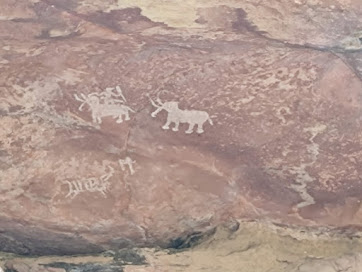Bhimbetka: Rock art and paintings by primeval man (Aadi Manav)
By Shashi
Chiplonkar
We are amazed and thrilled when we see the rock art and paintings at Bhimbetka exhibiting the earliest traces of human life in Indian subcontinent and evidence of stone age. Bhimbetka rock shelters are an archaeological site at the southern edge of the Vindhya Mountain ranges in the Raisen District of Madhya Pradesh, India. The site contains the world's oldest stone walls and floors.
This Rock shelter complex was first discovered by Dr V. S. Wakankar, in
1957. He named these rock formations as “Zoo Rock”. Zoo Rock includes 453
paintings and rock art of 16 species of 252 animals as well as 90 human
figures. Natural colours namely, red, white pigments, green and yellow from
vegetables and plants, wooden coal, soft red stone, manganese, animal fats are
used in these paintings. Archaeologists
believe that 21 colours have been used in the Bhimbetka rock paintings.
These rock
paintings are very similar to those of the
Savanna regions of Australia, the paintings done by pygmies of the Kalahari
Desert and the Paleolithic Lascaux cave paintings of France. Some rock
paintings in the Bhimbetka are of animals like bison, tigers, deer, and
rhinoceroses, indicate the paleolithic period. Paintings of squirrel,
chicken, human figures, hunting scenes and weapons such as bows, arrows
indicate Mesolithic periods. Out of about 750 rock shelters and paintings, only
12 to 15 are accessible to visitors. The main sites include 1) auditorium cave,
2) prehistoric paintings showing hunters, animals, battle scenes with horse
riders having weapons like swords, arrows, spears etc. and 3) rock formations
exhibiting elephants, deer, bison and barsingha. 4) Natraj painting of a man
dancing with trident, communal dances, children and mothers, cooking, and many
more daily activities. The customs and traditions reflected in these paintings
are practiced even today in nearby villages.






















Comments
Post a Comment